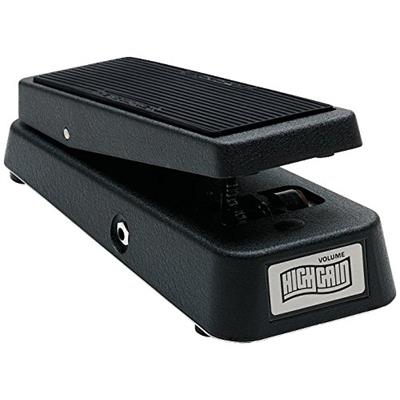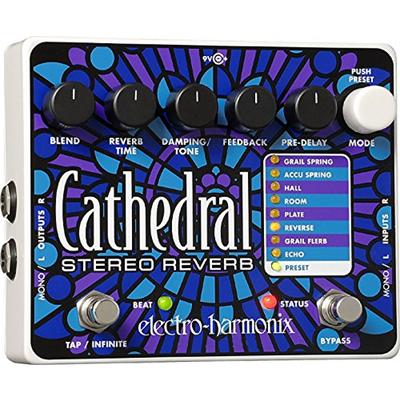| Build Quality: |  |
| Hardware: |  |
| Electronics: |  |
| Sound: |  |
| Value: |  |
| Average: |  |

Pros:
- Extremely durable
- Smooth operation
- Does not need a power supply
- Reliable
Cons:
- The pots (as with many potentiometers) might wear out after a while
- You cannot adjust the tension.
Dunlop manufacturing was born in 1965 when Jim Dunlop founded a small business that started off with creating tuners, capos and guitar picks. This genius engineer listened to the feedback from musicians about existing accessories and created the ones that combined everything customers lacked before. The brand made history when they occupied the wah market and continued launching Cry Baby pedals. They have gone through years of changes, innovations and improvements, but one thing remains unaltered – their quality always sets a high bar on the market. Though I do not think that talking about the brands with a generalized approach is not a correct attitude, I do also believe that sometimes you cannot help it. Some patterns simply cannot be neglected, don’t you agree? I have been a loyal customer of their products for years now and I have experienced all the highs and lows. Not once have I been completely disappointed, which is why I keep coming back to their units. Today I am going to introduce to you their GCB80 – a High Gain volume pedal that falls in the middle price range. This baby has a couple of remarkable features that turn it into a classic. Let’s continue and see what we have here!
Features
If somebody asked you to define simplicity and provide tangible proof for it, you could easily take Dunlop GCB80 and shake it in front of their face. And I am not even exaggerating. This is the type of unit that you just plug in and start performing. There is not even a single complicated thing about this baby, which is not surprising, considering the fact that we are talking about a volume pedal. GCB80 is a passive device, which means it does not require any external power in order to operate.
You can forget about the batteries, adapters and power supplies with this one and start counting the money you save. This fella utilizes potentiometers that can wear out through years of vigorous usage. Once it starts to have a scratchy voice, it is time to substitute the old pots with newer ones (but Dunlop promises that you will not have to do that until you reach the millionth cycle). This is a minor inconvenience that all the passive volume pedals share. More importantly, GCB80 works with high gain instruments a.k.a. electric guitars. You could try and utilize it with keyboards, but I do not think you would have much luck. This bad boy has rugged construction that could take a hit or two. Seriously, you can jump on it, drop it or abuse it however you want – it still will not fall apart. And one last thing, GCB80 looks extremely similar to the Cry Baby, you might even mix up the two if you do not pay attention. But since I love the looks of this legendary wah pedals, I do also really enjoy the design of this model. Nice work, Dunlop!
Controls
Huh, this is usually the hard part of reviews about volume pedals. But I am a fighter and I still power through. Okay, I barely have to say anything here, since the control selection of GCB80 is quite limited. This is not surprising or disappointing, because mostly we expect something like this when we decide to invest in a volume pedal. You get what you see here, there are no hidden gems under the hood or tweakable parameters snuggled in the circuitry. We have a pedal that creates changes in the volume and that’s it. If you tried to make things simpler, you would probably fail. You just have to learn how to move between different levels smoothly, which is something that you will definitely nail with practice. The taper mutes the signal completely when in heel-down position, so keep that in mind. If you do not want your sound to cut off immediately, be careful with your movements. The biggest part of tonal control here is within your foot action and ability to make precise adjustments. Anyway, this volume pedal is way more comfortable to jump around then the guitar volume control (and that is the whole point).
Dunlop GCB80 Sound
If you can tweak the knobs on other stompboxes in order to diversify your performance, with volume pedals you can change the placement and achieve similar results. Since GCB80 is passive, it is quite sensitive to any modifications and responds accordingly. What I mean is that the pedal will change the volume when you move it around, which can be equally a good or a bad thing. It depends on your requirements, I guess. I, personally, like to have different options to work with so I usually modify the chain quite often. I like to place GCB80 right in front of the chain to kind of boost the whole signal. Sometimes I put it right before distortion to intensify the effect a bit. Again, it depends on your personal choices. But you should also keep in mind that this pedal will work differently with different types of units (you do have to consider the impedance and active or passive nature). For me, GCB80 is quite colorless and clear, and I have not noticed any tonal loss either. However, some players have complained about it eating up the high-end (just a little bit), so I think you would have to test that yourself. On the whole, this pedal has a decent sound and offers smooth transitioning between the settings.
Conclusion
Even though I try to lower my expectations with each purchase, sometimes I cannot help myself and still have high hopes before my awaited treat arrives. When I was first buying GCB80 from Dunlop, I checked my delivery every day because I could not wait to try out (I would not meet people who are this excited about volume pedals). And once I did, I was not disappointed. Considering the price and features of this baby, it is undoubtedly that it is a powerful rival to other options on the market. Good luck!
Click here to view more from 10 Best Volume Pedals.






